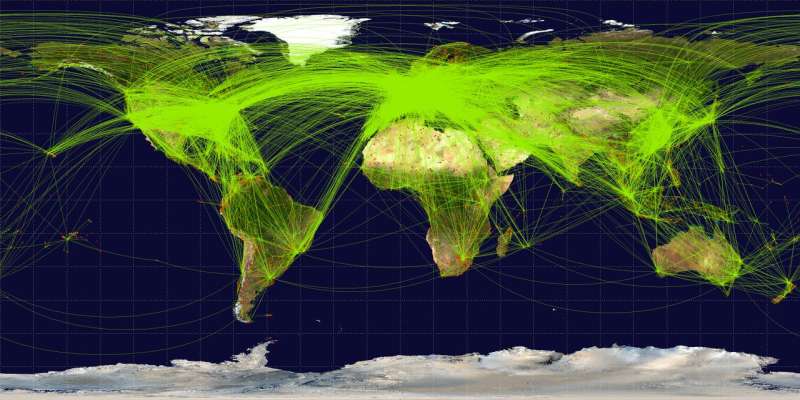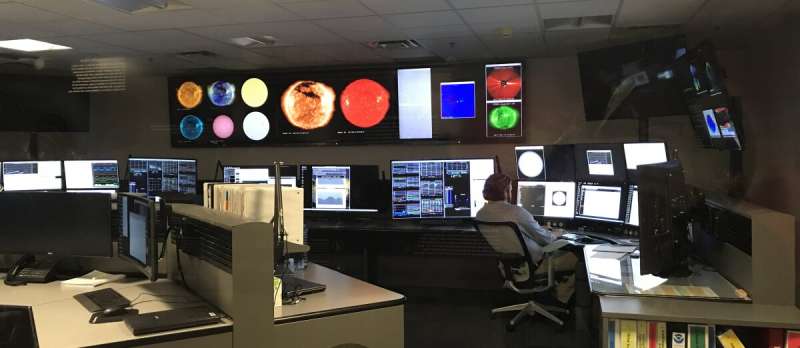New space weather advisories serve aviation

A new international advisory system is working to keep aircraft crew and passengers safe from space weather impacts, thanks in part to the efforts of a team of CIRES and NOAA developers, forecasters, and scientists in Boulder, Colorado.
"Thunderstorms or snow can disrupt flights. What we call 'space weather' can be disruptive, too," said Rob Steenburgh, a scientist and forecaster in NOAA's Space Weather Prediction Center (SWPC). So when the United Nations' International Civil Aviation Organization solicited interest from space weather centers around the globe to create a new advisory system for aviation, SWPC offered to help, on behalf of the United States.
"Space weather" generally refers to the changing conditions in space and in the Earth's atmosphere that result from activity originating on the Sun. Solar "winds" can ebb and flow, buffeting Earth's magnetic field, and when a coronal mass ejection (CME) passes by Earth, it can seriously shake up that magnetic field. Such "space weather" can temporarily disrupt navigation and communications systems and can even increase radiation levels in the atmosphere.
And—much as with a blizzard or looming thunderstorm—airlines can take action, changing an aircraft's flight path to avoid or lessen impacts, said CIRES solar physicist Hazel Bain, who worked on the project for the last year. A moderate radiation advisory, for example, might motivate airlines to divert planes from the polar regions, she said, since flights over the poles are more exposed to radiation than flights at lower latitudes. CIRES is a partnership of NOAA and the University of Colorado Boulder.
In late 2018, ICAO chose SWPC to be one of three forecast centers from around the world to begin issuing space weather advisories to the civil aviation community. Just 12 months later, SWPC's system was operational.
"This new capability will permit flight crew and flight operations experts to make use of the most updated information possible on any solar events which could potentially impact aircraft systems or passenger health," ICAO Secretary General Dr. Fang Liu said in a statement late last year.
The project focused on three main types of impact to aviation: Disruptions to satellite-based navigation; disruptions to HF radio communications, and radiation levels (see box below).

About 15 CIRES and NOAA scientists, software developers and forecasters spent the last year racing to design a system that would meet ICAO's specs—that organization decided, for example, what levels of radiation would constitute a "moderate" event and what "severe" disruption to global navigation satellite systems means.
For each type of impact, the team needed to develop or integrate models of the Sun-Earth environment, to support aviation 24/7. For radiation, for example, they brought in a Federal Aviation Administration model, Bain said. For satellite navigation warnings, they quickly finished a model that had been in the works already (ROTI or Rate of Total-Electron-Content Index). And for high-frequency communications, they leveraged another existing model, the CTIPe, for Coupled Thermosphere Ionosphere Plasmasphere Electrodynamics.
That was tricky enough. But the project also demanded careful attention to the user interfaces and e-tools forecasters would need to help them issue advisories on current conditions, and forecast conditions 6, 12, 18 and 24 hours out.
"We built intuitive interfaces by working directly with the forecasters," said Ben Rowells, a CIRES developer in SWPC. Forecasters are interested in a space weather phenomenon called ionospheric scintillation, for example, which can impact navigation. "A forecaster can select hotspot regions on an animated data map and rapidly issue an advisory," Rowells said.
Since late November, the SWPC team has been taking two-week turns with the other teams—both international consortia that developed independent advisory systems—to issue advisories.
"This was revolutionary," said NOAA's Steenburgh. "While there is still more work to be done, the models and user interface were made available to SWPC forecasters through a heroic effort from virtually all parts of SWPC."
In the three months since advisories began, no space weather center has issued "moderate" or "severe" warnings in any category, Steenburgh said. This lull won't last, however, as we move towards the next solar cycle maximum, estimated to arrive in about four years.
Provided by University of Colorado at Boulder




















